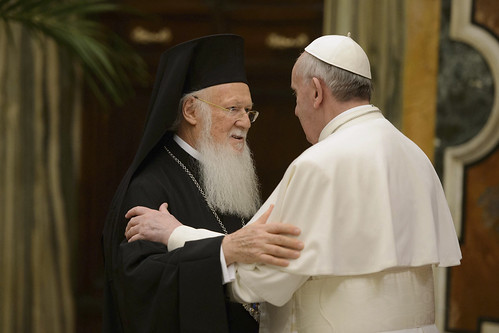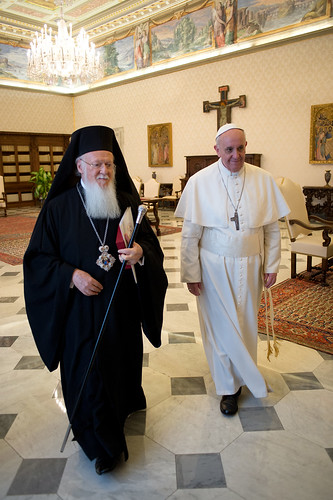Pope Francis’ Poverty Will be Forgotten
March 23, 2013 By 90 Comments
In this first week of his papacy Pope Francis has made some stunning and memorable gestures toward the Franciscan ideal of poverty. They have produced a fantastic splash of public relations positives, but they are not mere PR gimmicks. Jorge Bergoglio has lived a life of apostolic simplicity for many years, and he lives and works from a position of genuine affection for the poor and ministers positively for the poor.
However, the vast crowds (of mostly rich people) who profess to love his simplicity of life are responding sentimentally. There is a syrupy idea that the poor are wonderful just because they’re poor. There is also a very warm hearted feeling toward St Francis, who preached to the birdies and hugged trees and kissed lepers. This sentimental approach to poverty and ministry to the poor is shallow and naive. It’s the stuff of St Francis statues in the backyard, and the sickly sentimentality of that creepy sixties movie Brother Sun, Sister Moon in which a beautiful young Francis went tumbling through fields of flowers.
In fact, anyone who works with the poor realizes that it is very complicated. People are not noble and good simply because they are poor. The Franciscans I know are tough and hard headed and realistic. The latte sipping crowd who think the Pope is “just marvelous” because he doesn’t go in for the limousine or the trappings of the office are strangely deaf if we suggest that they follow his example. They’re all quiet happy for the Pope to sell off the riches of the church, but they’re not about to have a garage sale.
When Pope Francis gets down to work things will change. When his love of poverty shifts to criticism of the rich and powerful we’ll find that suddenly the media and the champagne socialists will not love him so much. When his love of the vulnerable and disabled shifts to criticism of euthanasia or defense of immigrants the non Catholics who think he’s a darling will decide that he’s a dark Lord. When his love of children and hatred of child abuse shifts to an attack on abortion and sex trafficking those who think he’s wonderful will soon say he’s wicked. When his love of old people and the family becomes a condemnation of divorce, pornography and homosexuality they’ll forget their affection for him and get out their knives.
When his kissing of prisoners’ feet shifts to calling for better conditions in prisons, for proper investment in rehabilitation programs and an end to the death penalty the warm opinion non Catholics have of him will soon crumble.
Not only will the worldlings dislike him, but so will Catholics. When his love of poverty shifts to a demand that we all follow his example and start tithing seriously all the Catholics who think he’s so wonderful will suddenly fall silent, put their tail between their legs and shuffle off home to their three car garages. When his love for the poor starts demanding that we re-examine our international trade practices they’ll forget that they loved his poverty. When his love for the peace makes him criticize the warrior country America they’ll soon forget how much they liked him. When his love for children and the family turns to an attack on the contraceptive culture they’ll perhaps not like him quite so much.
I predict that before too very long he’ll be under attack. The attacks will be vicious and cruel and unfair–like Christopher Hitchen’s famous attack on Mother Teresa of Calcutta. Pope Francis may continue to live in poverty and eschew the trappings of the papacy, but no one will notice. The “poverty effect” will be short lived. It will be played down, and if my hunch is right–it will even come under attack. The same members of the secular press who are now licking his hands will turn and bite him. They will say his “poverty” was a sham, a public relations stunt and that he is just another hypocritical Catholic prelate.
What may be even worse, is that Pope Francis’ public displays of poverty may overshadow his papacy, and that the members of the secular press (if they are very clever) will keep Pope Francis up front and center as a sentimental Franciscan-type figure, while studiously ignoring everything else he attempts to do. If they are really smart they will focus all the attention on the fact that he kisses the feet of AIDS patients, moves out of the papal apartments, wears black army boots and calls out to order a pizza all the time ignoring his real work of preaching the gospel and being a prophetic sign of contradiction to our age.
I hope readers will not mis understand this post. It is not an attack on Pope Francis’ embrace of poverty for the sake of the gospel. I am happy about the election and want to learn from this new Pope. However, I do think that the link with St Francis and “Lady Poverty” will be short lived, misunderstood or even be counter productive as I’ve outlined, and once the honeymoon period is over Pope Francis’ battle with the forces of darkness will begin in earnest. His embrace of poverty will help him win some battles in that war, but the war will be much bigger than the Franciscan gestures at poverty which have been so effective and productive so far.















